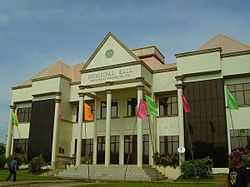Mahayag, Zamboanga del Sur
| Mahayag | |
|---|---|
| Municipality | |
|
Town hall | |
 Map of Zamboanga del Sur with Mahayag highlighted | |
.svg.png) Mahayag Location within the Philippines | |
| Coordinates: 08°08′N 123°23′E / 8.133°N 123.383°ECoordinates: 08°08′N 123°23′E / 8.133°N 123.383°E | |
| Country | Philippines |
| Region | Zamboanga Peninsula (Region IX) |
| Province | Zamboanga del Sur |
| District | 1st district of Zamboanga del Sur |
| Founded | March 9, 1960 |
| Barangays | 29 |
| Government[1] | |
| • Mayor | Lorna Saycon Espina |
| Area[2] | |
| • Total | 194.90 km2 (75.25 sq mi) |
| Population (2010)[3] | |
| • Total | 45,015 |
| • Density | 230/km2 (600/sq mi) |
| Time zone | PST (UTC+8) |
| ZIP code | 7026 |
| Dialing code | 62 |
| Income class | 3rd class; partially urban |
Mahayag is a third class municipality in the province of Zamboanga del Sur, Philippines. According to the 2010 census, it has a population of 45,015 people.[3]
History
The town's name is derived from the Cebuano term "mahayag" (ma = to become + hayag = bright) which means to become bright or sunny. When the Visayan migrants first trickled into the area after World War II, the place was heavily forested, which, to some looks dark and forbidding. Local historical sources had it that when a large "Dao" tree which stands in the townsite was felt, the place becomes bright, hence the expression "mahayag".
Mahayag used to be sitio of barangay Molave of the municipality of Aurora. Early settlers of the area had endeavored for the creation of another municipality to fast-track development which is possible only by having a distinct political subdivision from the municipality of Molave. The town site for the new municipality was donated by Zacarias dela Torre and Pedro Alquizar.
The municipality of Mahayag was officially created on March 9, 1960, pursuant to Executive Order No. 393 by President Carlos P. Garcia, with Saturnino Mendoza as its first appointed and subsequently elected Municipal Mayor. It was formed by the separation of 20 barrios from the municipality of Molave and 3 barrios from the municipality of Dumingag.[4]
Barangays
Mahayag is politically subdivided into 29 barangays.[2]
- Bag-ong Balamban
- Bag-ong Dalaguete
- Boniao
- Delusom
- Diwan
- Guripan
- Kaangayan
- Kabuhi
- Lourmah (Lower Mahayag)
- Lower Salug Daku
- Lower Santo Niño
- Malubo
- Manguiles
- Marabanan (Balanan)
- Panagaan
- Paraiso
- Pedagan
- Poblacion (Upper Mahayag)
- Pugwan
- San Isidro
- San Jose
- San Vicente
- Santa Cruz
- Sicpao
- Tuboran
- Tulan
- Tumapic
- Upper Salug Daku
- Upper Santo Niño
Demographics
| Population census of Mahayag | ||
|---|---|---|
| Year | Pop. | ±% p.a. |
| 1990 | 37,690 | — |
| 1995 | 40,806 | +1.50% |
| 2000 | 42,462 | +0.86% |
| 2007 | 44,087 | +0.52% |
| 2010 | 45,015 | +0.76% |
| Source: National Statistics Office[3] | ||
Local government
2013-2016 Municipal officials:[1]
- Mayor: Lorna S. Espina
- Vice Mayor: Camila T. Diaz
- Councilors:
- Jaime Edullantes
- Teomila A. Nobleza
- John Ranile
- Ping Caylan
- Boning Nobleza
- Helen Maglasang
- Raquel Frasco
- Abel Sebandal
Lorna Saycon Espina, the incumbent Municipal mayor, is the 9th Municipal Mayor of the Municipality of Mahayag. Past mayors include Paulino P. Fanilag, Carlito A. Lumacang as OIC-Mayor following the EDSA I Revolution, and Perpetuo C. Apale, the appointed Officer-in-Charge in the Office of the Municipal Mayor during the first election after the ratification of the 1987 Constitution.
Tourist destinations

Mahayag is also rich in naturals resources reserve. Tuburan, a remote barangay on the eastern part of the town, is famous for its cold and freezing natural springs. Three private resorts and swimming pools were put up to cater adventurous spirits.
Education
In addition to the daycare centers in each barangay, at least one (1) public elementary school exists in each of the 29 barangays in the municipality.
There are four (4) public high schools and one private highschool run by the Catholic Church in the municipality.
Although permitted to operate and offer Collegiate courses since the later part of the 1990s, no tertiary courses had been offered by the Santa Maria Goretti College except during the time when it served as an extension campus of the Saint Columban College (Pagadian).
College students who cannot afford to obtain their education from far places like Ozamiz or Pagadian, may still attend college at the Pagadian Institute of Technology (PIT) campus in Mahayag, and Josefina H. Cerilles State College.
References
- ↑ 1.0 1.1 "Official City/Municipal 2013 Election Results". Intramuros, Manila, Philippines: Commission on Elections (COMELEC). 12 May 2014. Retrieved 17 July 2014.
- ↑ 2.0 2.1 "Province: ZAMBOANGA DEL SUR". PSGC Interactive. Makati City, Philippines: National Statistical Coordination Board. Retrieved 16 July 2014.
- ↑ 3.0 3.1 3.2 "Total Population by Province, City, Municipality and Barangay: as of May 1, 2010". 2010 Census of Population and Housing. National Statistics Office. Retrieved 16 July 2014.
- ↑ "Executive Order No. 393: Creating the Municipality of Mahayag in the Province of Zamboanga del Sur". Official Gazette. Manila, Philippines: Presidential Communications Development and Strategic Planning Office. May 10, 1960. Retrieved 22 July 2014.
External links
| Wikimedia Commons has media related to Mahayag, Zamboanga del Sur. |
 |
Sergio Osmeña Sr., Zamboanga del Norte |  | ||
| Dumingag | |
Molave | ||
| ||||
| | ||||
| Sominot | Ramon Magsaysay |
| ||||||||||||||||||
